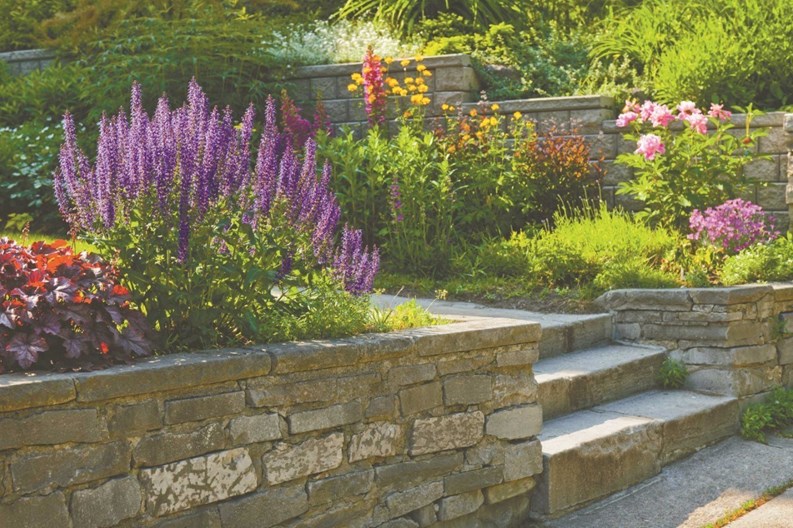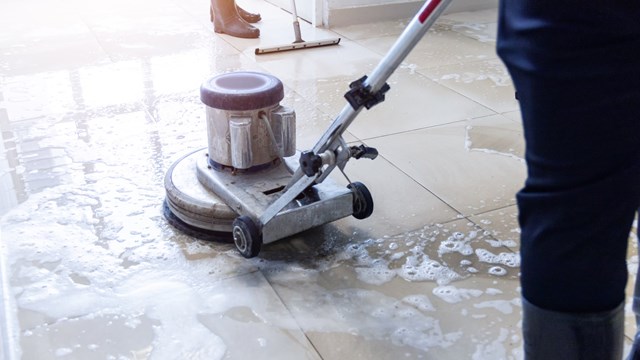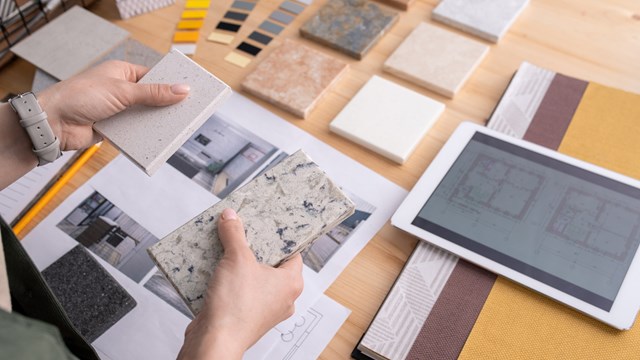Whether enhancing a towering high-rise or a sprawling suburban development, landscaping not only helps a condo or HOA increase and retain property values, but has a positive impact on residents themselves. Beautiful, functional green spaces and plantings increase pride of ownership, influence morale, and just generally make a place more pleasant to be in for owners and visitors alike. And unless there happens to be a master gardener or landscape architect on a building board or grounds committee, chances are that the community’s administrators will have to call upon a professional landscape specialist to help make the most of their property’s potential.
“You want to have a cohesive design, the whole thing to feel as one unit, and if you didn’t do a design, it wouldn’t be as appealing or attractive,” says Kathleen Curtiss, owner of Doug Curtiss Landscape Design in Southborough, Massachusetts.
Curb appeal is key. “The entry statement becomes very important, what they’re actually going to see at the street, how’s it going to look with the rest of the neighborhood,” says Jane Didona, a principal of Didona Associates Landscape Architects in Danbury, Connecticut.
Before You Make the Call
Everyone agrees a nice landscape is a positive thing for an association, but it’s important to consider when to hire a landscape designer, and to have an idea of what’s needed. For condos and HOAs, the landscape may be dated, or a poor design may be in place. Simple factors like location and environment determine what plants can thrive where. A design is going to depend largely on what kind of area is involved. “When you’re working with a condo board, it’s usually an already-built project; it’s not new construction. You’re either doing renovation or expansion of a recreation area or something,” says Didona.
High-traffic areas bring salt and other harsh chemicals onto nearby plants, so the knowledgeable designer will choose plants that tolerate salt well. A lot of factors go into deciding the best plants to use, and where—but good landscape architects and designers know them like the backs of their hands, and as long as the professionals can assess a property well, implementation doesn’t require much guesswork.
With the terrain in mind, landscape designers will tell associations that they need to have an idea of what purpose they want a landscape to serve, and some boards have landscape committees to help with the big decisions. “The landscape committees that I work with, you generally have some people with some knowledge,” says John Russ, vice president of Village Green Landscape & Lawn Care Service in Holliston, Massachusetts. “The management company will come to me, and sometimes, a condo will have a landscape committee. Then the property manager will tell me to meet with the landscape committee.”
A Balancing Act
“Condos are trying to balance, without spending $100,000 to redesign part of their property; but with a smaller space, you can’t get into a technical design, like retaining walls, or waterfalls,” says Russ. If associations don’t have experience with landscape design they can consult with designers to get an idea of what they’re looking for. “A landscape committee will show me the ideas they have in their mind. Once we get narrowed down what they want, then I put it on paper and come up with prices. Some of my lists have been 20 or 30 items. They review the budget and pick off that list,” says Russ.
Most associations in New England tend to be pretty well maintained, but maybe the current lawn and those few trees just aren’t cutting it anymore, or maybe they’re not doing as well, or maybe the soil is starting to face drainage issues. Once associations and designers are in agreement on what the intended use is, careful planning should follow. Some major projects get done at one time, but most landscape work is piecemeal. “What I’ve done with customers is take little pieces of the property. It’s a year-to-year, what can we do to improve this part here. It’s a constant reviewing of what you’ve done in the past, and adding on to it,” says Russ.
Especially for those who have never worked with a landscape designer, simply finding the right one can be stressful—partly because pricing can be difficult. Much of the cost of a project depends on what materials will be used, and how much labor is required. For that reason, competitive bidding can be tricky: The lower bid might not be fulfilling everything asked for in the plan. If an association gets suspicious of a big price tag, they can always get a second opinion. But, in general, budget determines a lot about the parameters of a project—what can and what can’t be done.
Understandably, associations want their landscape designs to be noticeable. Three-season designs are always a big concern; people want an interesting design for the three seasons,” says Curtiss. “I try not to put in plants that require a lot of spraying or pruning because people want to keep those maintenance costs low.” The level of maintenance required for plants is also a large deciding factor. One plant might not cost much to install, but if it grows fast and needs to pruned often, for instance, the labor costs needed to keep the landscape looking tip-top will dwarf the initial costs. “I try keep plans maintenance-free. You get into these complicated designs, or big plantings—it costs money to maintain them,” says Russ.
A Sustainable Landscape
Landscape professionals are also concerned with larger questions, things like sustainability, and are able to take cues from a perspective that’s larger than the property lines of the site where work is to be done. Using plants native to the area can make an association’s landscape much healthier and more durable. “We try to encourage native plant material,” says Didona. “The problem we have is without the dedication of the condo board in the beginning to really monitor that, it will result in the invasive species coming back in. So you really need to put together a pragmatic plan in order to get these things established.”
Environmentally-friendly practices don’t just deal with what materials to use—they also involve practices and maintenance. “I went to one site where their plants just were not thriving and they really felt it was the maintenance. When we did soil testing we found there was no topsoil on the property at all,” says Didona. “Now there’s all sorts of techniques we use to mitigate drainage issues that weren’t available 20 years ago.” One technique is the use of a rain garden. “It’s basically a garden that’s not raised, rather it’s more concave, so it collects water, but not too much water, and it’s got permeable soil and a base that allows for infiltration into the ground water, which is a much better way of addressing storm water than just collecting it into the pipes and taking it off site,” says Didona.
Some environmental factors are a hindrance to landscapes. In areas with more undeveloped land, deer and other animals become a big problem for plants. If you’re in an area that’s very rural, say you’re surrounded by a lot of woods that aren’t fenced in, you’re going to want to use plants that are deer-resistant—which is a huge concern in a lot of areas, even in suburbia,” says Curtiss. Communities that come up against this problem on a regular basis should consider plants that are not favored by deer and other animals, he says.
Condo boards tend to make decisions on their own time but timing can play an important factor in whether a project gets done in the same year it began. “It depends what you’re doing, but we usually start at the end of March and work until frost is in the ground. Let’s say you’re doing hardscape work, walkways and that, you can’t grade sand and do that when it’s freezing in the morning and everything’s rock solid. So there’s usually three or four months that we’re not able to work,” says Curtiss.
Be Aware of Local Ordinances
Local city and town codes are another factor that boards and associations definitely need to be aware of. “Most towns have requirements as far as street trees and street lighting. Some of them require pedestrian access. All of those become issues through the permit process,” says Didona. “In Connecticut it’s very town-by-town, because Connecticut doesn’t really have a major or strong regional government.” There are also codes on existing plant materials. “The smart [codes] are the ones that require you to save as many existing trees as possible, assuming the site is wooded. If there’s any mature trees—you can never grow a 36-inch oak in our lifetime—so it makes more sense to take a look at the existing vegetation and see what’s there,” says Didona.
Bodies of water also need to be considered in New England. “Each town has their own wetland bylaws. You would have to know are there wetlands nearby. Riverfront areas are one of the most protected. But some [communities], you can’t touch anything within 100 feet. Each town has their own bylaws. You want to talk to the conservation commission and make sure you’re in line with the laws,” says Curtiss.
Landscape design can be a huge investment. But it’s not a needless detail. A well thought-out design can enhance more aspects of home life than just the property value. In a uncertain real estate market, a beautiful landscape can keep values up when there’s more competition in the market than usual. But ultimately, the returns come back when residents use the space and appreciate the outdoors. “There’s a sense of pride. People I’ve worked with have come back to me, and said that when other people drive there who don’t live there, and say how beautiful it is, they were proud to be part of it. When you’re walking your dog, and you see flowers blooming here and there, you know it’s nice, it’s beautiful,” says Russ.
Denton Tarver is a freelance writer and a frequent contributor to New England Condominium. Editorial Assistant Tom Lisi contributed to this article.







Leave a Comment